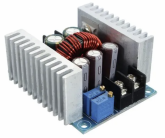RCinFLA
Solar Wizard
- Joined
- Jun 21, 2020
- Messages
- 3,559
I can recommend a relatively inexpense buck converter to triple your output current from a typical 30v 5 amp power supply for LFP top balancing. You can even use an old computer power supply 12v output to feed the buck converter.
The buck converter is SZBK07 based on LM25116 synchronous buck switcher. Also sold as Geekcreit® DC 6-40V To 1.2-36V 300W 20A Constant Current Adjustable Buck Converter.
It is synchronous buck converter using two 75v/90A IRFB3607 MOSFET's which gives it a conversion efficiency between 90-95%.
I would not use it with an output above 15 amps as the heat sink will get pretty warm. With 12v input it will draw less then 5 amps from feeding supply.
Keep in mind the output wire gauge to avoid voltage drop at the 15 amps. I used #8 gauge wire with soldered lugs. Set output voltage to 3.65 vdc. Set current limit to 15 amps or less. I only saw about a tenth of volt drop at output terminal with a 15 amp output load.
They are being sold for about $8 with couple dollars for shipping.

The buck converter is SZBK07 based on LM25116 synchronous buck switcher. Also sold as Geekcreit® DC 6-40V To 1.2-36V 300W 20A Constant Current Adjustable Buck Converter.
It is synchronous buck converter using two 75v/90A IRFB3607 MOSFET's which gives it a conversion efficiency between 90-95%.
I would not use it with an output above 15 amps as the heat sink will get pretty warm. With 12v input it will draw less then 5 amps from feeding supply.
Keep in mind the output wire gauge to avoid voltage drop at the 15 amps. I used #8 gauge wire with soldered lugs. Set output voltage to 3.65 vdc. Set current limit to 15 amps or less. I only saw about a tenth of volt drop at output terminal with a 15 amp output load.
They are being sold for about $8 with couple dollars for shipping.

Last edited:


